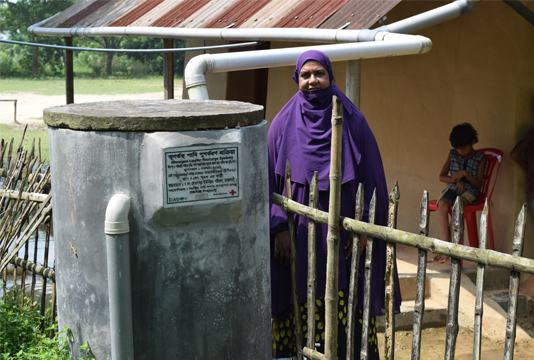By Dr Aynal Haque
RAJSHAHI, Oct 19, 2020 (BSS)- Nasrin Begum, 38, has exposed herself as potential for managed aquifer recharge (MAR) since her engagement in the process in the drought-prone Barind area for the last couple of years.
Begum, wife of Muhammad Sumon of Ishwaripur village in Dewpara Union under Godagari Upazila of Rajshahi district, has been harvesting rainwater and inserting those to the underground since 2017 last.
“We have arrangements of harvesting all the rainwater from the rooftop of our tin-shed house and injecting those to the underground,” she said, adding the continuous artificial aquifer recharge has already started benefiting them.
Begum is using the conserved water for household purposes through a tap fixed in the lower part of the tank. Surplus water is being conserved in the recharge tank through another upper portion wide pipe.
Earlier, there was no water in hand-driven tube-wells from March to June every year causing huge sufferings to the people, particularly the marginal ones. But, the troubled situation has started changing as a result of promoting MAR, a modern technology of artificial aquifer recharge, at present.
Many other households, business establishments and local government institutions like Nasrin Begum have installed MAR technology in the drought-hit Barind area.
They are getting technical and financial assistance from the Integrated Water Resource Management (IWRM) Project for successful and effective promotion of MAR along with its operation.
“150 MAR in community level, 43 in local government institutions and four other in business establishments have, so far, been installed in the drought-affected areas,” said Jahangir Alam Khan, coordinator of IWRM project.
Abdur Rashid, Mayor of Nachole pourasava in Chapainawabganj, said underground water level has started rising by dint of promoting the technology although it has been installed in limited scale.
He said there is a big scope of elevating the groundwater level through large-scale promotion of the technology as the issue of abnormal lowering of underground water layer has become a grave concern in the high Barind tract.
Rashid advocated for incorporating the MAR issue in the existing house building policy so that it can be mandatory in each of the houses for the sake of halting the alarming rate of declining underground water.
In the drought-prone area, people, however, are now becoming more conscious to halt the alarming decline of the groundwater layer. Aquifer recharge activities are being done at household level side by side with various institutions and industries artificially.
Augustin Hasda, 45, a farmer of Mondumala village under Tanore Upazila, has arranged a aquifer recharge system in his house.
He is harvesting rainwater from around 3,000 square feet of rooftop area of seven rooms through 4-inch diameter PVC pipe and conserving those in tanks constructed with one-foot height and three-feet diameter six concrete ring slabs.
After filtering there the stored water is being injected into a 140 feet underground sand layer. House-owner Augustin Hasda said the IWRM Project inspired him and extended financial support to the venture.
He viewed if his neighbours take initiative to aquifer recharge and use water judiciously the desired result will come obviously.
The IWRM project is being implemented in drought affected 39 union parishads and three pourasavas in eight upazilas of Rajshahi, Naogaon and Chapainawabganj districts.
DASCOH Foundation and Swiss Red Cross have jointly been implementing the project with financial support from Swiss Agency for Development and Cooperation-SDC since 2015.
There are 32 heavy auto rice mills within three square kilometers of the water-stressed Jhilim Union under Chapainawabgonj district. The mills extract huge underground water every day through 120 deep tube-wells. For this reason, the nearby tube-wells became non-functional.
So, the then Jhilim UP Chairman Tasiqul Islam had taken necessary initiative so that the entire auto rice mills can send their rooftop rainwater to ground water layer. Responding to his call Mukhlesur Rahman, owner of Jotsna Auto Rice Mill, has adopted the necessary step of aquifer recharge through injecting rainwater of his 60,000 square-feet rooftop area.
Tasiqul Islam had a farsighted plan of aquifer recharge through sending rainwater of 25 lakh squire-feet rooftop area of all 32 auto rice mills and he intended to materialize his dream.



